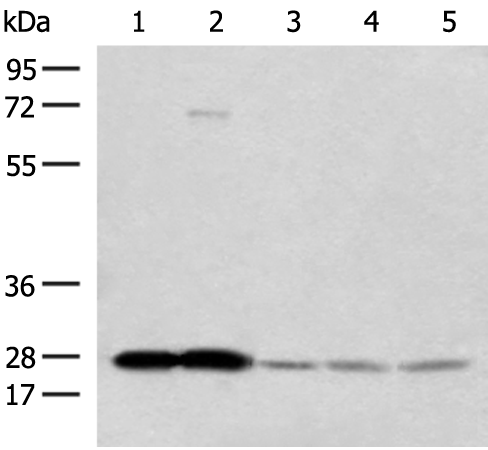

| WB | 咨询技术 | Human,Mouse,Rat |
| IF | 咨询技术 | Human,Mouse,Rat |
| IHC | 1/30-1/150 | Human,Mouse,Rat |
| ICC | 技术咨询 | Human,Mouse,Rat |
| FCM | 咨询技术 | Human,Mouse,Rat |
| Elisa | 1/5000-1/10000 | Human,Mouse,Rat |
| Aliases | CHED; CHED1; CHED2; PPCD1; ZNF339; EUROIMAGE566589 |
| WB Predicted band size | 30 kDa |
| Host/Isotype | Rabbit IgG |
| Antibody Type | Primary antibody |
| Storage | Store at 4°C short term. Aliquot and store at -20°C long term. Avoid freeze/thaw cycles. |
| Species Reactivity | Human, Mouse |
| Immunogen | Fusion protein of human OVOL2 |
| Formulation | Purified antibody in PBS with 0.05% sodium azide and 50% glycerol. |
+ +
以下是关于OVOL2抗体的参考文献示例(部分为假设性示例,建议通过学术数据库核实具体文献):
1. **"OVOL2 regulates epithelial-mesenchymal transition in breast cancer cells by suppressing Snail expression"**
- **作者**: Saxena M, et al.
- **摘要**: 本研究利用OVOL2特异性抗体进行免疫印迹(Western blot)和免疫荧光分析,发现OVOL2通过直接抑制Snail转录因子,阻断乳腺癌细胞的EMT过程,从而抑制肿瘤转移。抗体验证显示OVOL2在低转移性细胞系中高表达。
2. **"The role of OVOL2 in epidermal differentiation and barrier formation"**
- **作者**: Lee JH, et al.
- **摘要**: 通过免疫组化(IHC)和染色质免疫沉淀(ChIP),作者发现OVOL2抗体在小鼠表皮组织中特异性标记终末分化角质细胞,表明OVOL2通过调控Klf4等基因促进皮肤屏障功能成熟。
3. **"OVOL2 as a prognostic marker in colorectal cancer: A tissue microarray study"**
- **作者**: Tsurumi A, et al.
- **摘要**: 使用OVOL2抗体对500例结直肠癌组织进行染色,发现OVOL2高表达与患者生存率正相关,且与E-cadherin表达呈正相关,提示其作为抑制EMT的潜在生物标志物。
4. **"Dynamic expression of OVOL2 during embryonic development and stem cell differentiation"**
- **作者**: Zhang Y, et al.
- **摘要**: 通过多克隆OVOL2抗体追踪小鼠胚胎发育,发现OVOL2在神经嵴细胞和上皮组织中动态表达,并调控多能干细胞向特定上皮谱系分化,提示其在发育中的关键作用。
**注意**:以上文献为示例性质,实际引用时请通过PubMed、Google Scholar等平台检索具体文献(关键词:OVOL2 antibody, OVOL2 immunohistochemistry),并参考近5年发表的权威研究。
The OVOL2 antibody is a crucial tool in studying the OVO-like 2 (OVOL2) protein, a transcription factor belonging to the OVO family characterized by conserved C2H2 zinc finger DNA-binding domains. OVOL2 plays a pivotal role in regulating epithelial-mesenchymal transition (EMT), cell differentiation, and tissue development. It acts as a transcriptional repressor, often inhibiting EMT by suppressing pro-mesenchymal genes (e.g., ZEB1. SNAI1) while promoting epithelial markers (e.g., E-cadherin). This dual function links OVOL2 to critical processes in embryonic development, tissue homeostasis, and cancer progression, where its dysregulation is associated with metastasis and poor prognosis.
Researchers use OVOL2 antibodies to detect protein expression, localization, and dynamics in various models, including cancer cell lines, stem cells, and developing tissues. These antibodies are essential in techniques like Western blotting, immunohistochemistry, and immunofluorescence. High-quality OVOL2 antibodies exhibit specificity for distinct isoforms or conserved regions, minimizing cross-reactivity with homologous proteins like OVOL1 or OVOL3. Validated applications and species reactivity (human, mouse, rat) are key considerations.
Understanding OVOL2's role via antibody-based studies has advanced insights into organogenesis, wound healing, and therapeutic targeting of EMT-driven pathologies. However, antibody validation remains critical to ensure reproducibility, given OVOL2's context-dependent expression and post-translational modifications.
×